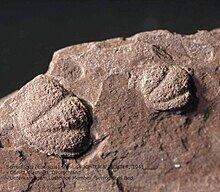Class Trilobita Rank Genus | Order Agnostida Superfamily Eodiscoidea | |
 | ||
Similar Callavia, Eodiscina, Delgadella, Eodiscus | ||
Serrodiscus is an extinct genus from a well-known class of fossil marine arthropods, the trilobites. It has been collected from the Lower Cambrian of Canada (Nova Scotia), Germany (Silesia), Poland (Holy Cross Mountains), Russia (Kuznetsk Alatau), the United Kingdom (Wales) and the United States (Massachusetts, New York State). It is named for the spines on the ventral side of the tailshield (or pygidium, which give it a serrated impression.
Contents
Distribution
Description
Like all Agnostida, Serrodiscus is diminutive. Like all Weymouthiidae, Serrodiscus lacks eyes and rupture lines (or sutures). The cephalon is semi-elliptical. The central raised area (or glabella) is conical, tapering forward, or is parallel sided. Usually it has weak or effaced furrows. The front of the glabella does not touch the furrow that defines the border, permitting the cheeks to join anteriorly in short preglabellar field or these are separated by a depression. As most backward part of the glabella the occipital ring is defined by a furrow. It may or may not carry a backward-directed spine. The border defined by a furrow is convex, with up to eight pairs of tubercles laterally. The articulate middle part of the body (or thorax) has three segments. The tailshield (or pygidium has a wide, subconical axis of more than eight rings. The pleural areas to the right and left of the axis lack furrows or are extremely weakly furrowed (on the internal mold only). The border becomes narrower further backwards and usually carries about 8 ventral spines at each side.
Behaviour
Like all trilobites Serrodiscus could protect its soft underside by rolling and it has been demonstrated that the ventral spines on the pygidial doublure fit beneath the nodes on the cephalic border, probably improving the defence of its belly.
